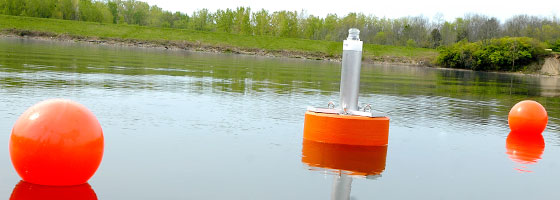Using Real-Time Monitoring for Critical Water Resources

Monitoring the world’s most critical freshwater resources is increasingly of interest to many nations. By monitoring the quality of the water using real-time technology, it is easier to enforce anti-pollution regulations as well as to observe and respond to other negative impacts. The information gathered through such monitoring efforts also aids in a better understanding of how human activity directly affects water quality.
One increasingly relevant parameter that can be measured by monitoring systems is chlorophyll, the concentration of which can indicate a water body’s fertility. Since chlorophyll fluoresces when irradiated with light of a particular wavelength, chlorophyll sensors can measure its concentration by using a light emitting diode with a peak wavelength of 470 nm. A highly sensitive photodiode can then quantify the amount of chlorophyll-specific fluorescence (within the 650-700 nm region of the spectrum). Greater chlorophyll concentrations indicate higher fertility and turbidity of the water. Changes in chlorophyll concentrations can be followed over a period of time to assess long-term nutrient-loading trends.
Other factors to consider when monitoring water quality are the temperature of the water, pH levels, turbidity, and dissolved oxygen concentrations. Higher temperatures mean the water’s ability to contain solids increases. However, the water’s capacity for dissolved oxygen decreases. Healthy bodies of water typically have high levels of DO. Water brimming with organic waste is oxygen poor because microorganisms that break down the waste use up the oxygen.
Increased soil erosion, dissolved solids, or microorganisms’ overgrowth can cause turbidity. As a result, light is limited or can be completely blocked, killing plants and thus decreasing DO. Decreased concentrations of DO impair the health of aquatic animals, possibly becoming lethal. Oxygen is one of a number of dissolved gases present in healthy body of water with high quality of life for aquatic organisms.
Water quality can be assessed via grab-sampling or real-time monitoring. Grab-sampling requires turnaround time in the lab to receive results, and collecting the samples can often be time- and resource-intensive. Real-time monitoring systems, on the other hand, are able to deliver results immediately and require minimal cost and time, aside from regular calibration and tune-ups, after the initial investment.
Data loggers are capable of delivering real-time measurements using a number of communication methods. NexSens data loggers, for example, support satellite, cellular, and radio telemetry. Satellite is ideal for monitoring water systems in remote areas where there is no cellular coverage.
The cellular option is optimal in developed areas with access to cellular coverage. Radio transmission is fitting for short ranges and is often the preferred mode of communication, as it requires no monthly data fees.
The NexSens MB-100 Inland Lakes Data Buoy is perfect for short-term monitoring or portable water monitoring stations. It can float or be used as a sub-surface buoy using the NexSens SDL500 Submersible Data Logger. The MB-100 is light enough to be deployed by one person.
The NexSens MB-300 Inland Lakes Data Buoy is optimal for distributing temperature strings and other monitoring equipment in lakes, streams or rivers. The NexSens CB-100 Coastal Data Buoy is ideal for monitoring highly traveled waterways. Its bottom cage provides convenient storage for additional monitoring equipment. All data buoys support cellular, radio, and satellite telemetry options.
For more information concerning real-time water quality monitoring, contact a Fondriest application engineer at 888.426.2151 or email customercare@fondriest.com.





0 comments